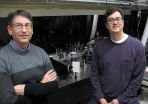Computer network rivals primate brain in object recognition
2014-12-18
(Press-News.org) Primates visually recognise and determine the category of an object even at a brief glance, and to date, this behaviour has been unmatched by artificial systems. A study publishing this week in PLOS Computational Biology has found that the latest artificial "deep neural network" performs as well as the primate brain at object recognition.
Charles Cadieu and colleagues from MIT measured the brain's object recognition ability by implanting arrays of electrodes in the inferior temporal cortex of macaques. This allowed the researchers to see the neural representation -- the population of neurons that respond -- for every object that the animals looked at.
When comparing these results with representations created by the deep neural networks, the accuracy of the model was determined by whether it grouped similar objects into similar clusters within the representation.
This improved understanding of how the primate brain works could lead to better artificial intelligence and provide insight into understanding primate visual processing.
"The fact that the models predict the neural responses and the distances of objects in neural population space shows that these models encapsulate our current best understanding as to what is going on in this previously mysterious portion of the brain," say the authors.
INFORMATION:
All works published in PLOS Computational Biology are Open Access, which means that all content is immediately and freely available. Use this URL in your coverage to provide readers access to the paper upon publication: http://www.ploscompbiol.org/article/info:doi/10.1371/journal.pcbi.1003963
Contact: Charles Cadieu
Address: Massachusetts Institute of Technology
Brain and Cognitive Sciences
77 Massachusetts Ave, 46-6161
Cambridge, MA 02139
UNITED STATES
Phone: 15162200119
Email: cadieu@mit.edu
Citation: Cadieu CF, Hong H, Yamins DLK, Pinto N, Ardila D, et al. (2014) Deep Neural Networks Rival the Representation of Primate IT Cortex for Core Visual Object Recognition. PLoS Comput Biol 10(12): e1003963. doi:10.1371/journal.pcbi.1003963
Funding: This work was supported by the U.S. National Eye Institute (NIH NEI: 5R01EY014970-09), the National Science Foundation (NSF: 0964269), and the Defense Advanced Research Projects Agency (DARPA: HR0011-10-C-0032). CFC was supported by the U.S. National Eye Institute (NIH: F32 EY022845-01). The funders had no role in study design, data collection and analysis, decision to publish, or preparation of the manuscript.
Competing Interests: The authors have declared that no competing interests exist.
About PLOS Computational Biology
PLOS Computational Biology (http://www.ploscompbiol.org) features works of exceptional significance that further our understanding of living systems at all scales through the application of computational methods. All works published in PLOS Computational Biology are Open Access. All content is immediately available and subject only to the condition that the original authorship and source are properly attributed. Copyright is retained. For more information follow @PLOSCompBiol on Twitter or contact ploscompbiol@plos.org.
About PLOS
PLOS is a nonprofit publisher and advocacy organization founded to accelerate progress in science and medicine by leading a transformation in research communication. For more information, visit http://www.plos.org.
ELSE PRESS RELEASES FROM THIS DATE:
2014-12-18
A definitive geological timeline shows that a series of massive volcanic explosions 66 million years ago spewed enormous amounts of climate-altering gases into the atmosphere immediately before and during the extinction event that claimed Earth's non-avian dinosaurs, according to new research from Princeton University.
A primeval volcanic range in western India known as the Deccan Traps, which were once three times larger than France, began its main phase of eruptions roughly 250,000 years before the Cretaceous-Paleogene, or K-Pg, extinction event, the researchers report ...
2014-12-18
(Boston)--Dr. Deborah Anderson from Boston University School of Medicine (BUSM) and her colleagues are challenging dogma about the transmission of the human immunodeficiency virus type 1 (HIV-1). Most research has focused on infection by free viral particles, while this group proposes that HIV is also transmitted by infected cells. While inside cells, HIV is protected from antibodies and other antiviral factors, and cell-to-cell virus transmission occurs very efficiently through intercellular synapses. The Journal of Infectious Diseases (JID) has devoted their December ...
2014-12-18
EUGENE, Ore. -- Dec. 18, 2014 -- Four pulses of laser light on nanoparticle photocells in a University of Oregon spectroscopy experiment has opened a window on how captured sunlight can be converted into electricity.
The work, which potentially could inspire devices with improved efficiency in solar energy conversion, was performed on photocells that used lead-sulfide quantum dots as photoactive semiconductor material. The research is detailed in a paper placed online by the journal Nature Communications.
In the process studied, each single photon, or particle of ...
2014-12-18
Washington, DC--As people in developing nations relocate from rural areas to cities, the increased stress is affecting their hormone levels and making them more susceptible to diabetes and other metabolic disorders, according to a new study published in the Endocrine Society's Journal of Clinical Endocrinology & Metabolism (JCEM).
About 387 million people worldwide have diabetes, and 77 percent of them live in low- and middle-income countries, according to the International Diabetes Federation. In the Middle East and north Africa, one in 10 adults has diabetes.
One ...
2014-12-18
Washington, DC--Women who experience moderate to severe hot flashes and night sweats during menopause tend to have lower bone mineral density and higher rates of hip fracture than peers who do not have menopausal symptoms, according to a new study published in the Endocrine Society's Journal of Clinical Endocrinology & Metabolism.
Menopause is the life stage when a woman's ovaries stop producing hormones and her menstrual periods stop. About 60 percent of women experience hot flashes, which can last for several years.
Postmenopausal women face a greater risk of developing ...
2014-12-18
MAYWOOD, Ill. - A drug called ganciclovir is given to lung transplant patients to protect against a life-threatening virus that is common after transplantation.
Ganciclovir reduces mortality due to the virus from 34 percent to between 3 and 6 percent. But between 5 percent and 10 percent of patients infected with the virus have strains that are resistant to the drug.
A Loyola University Medical Center study found that such resistance may occur more frequently in cystic fibrosis patients. These patients were found to have insufficient levels of the drug in their bloodstream, ...
2014-12-18
A group of researchers from the University of Barcelona (Spain), the CNRS in Montpellier (France) and Princeton University (USA) report in The American Naturalist that the vaccination of females of a long-lived seabird species, the Cory's shearwater, results in levels of antibodies that allow their transmission to their offspring for several years and could provide several weeks of protection after hatching to these offspring.
Over a period of 6 years, in the Canary Archipelago (Spain), the researchers tracked the immune status of a large number of adults and chicks, ...
2014-12-18
VIDEO:
Using data from NASA/USGS satellite Landsat 8, scientists have measured how vegetation in the Colorado River Delta has responded to the pulse of water released in March 2014 as part...
Click here for more information.
A pulse of water released down the lower reaches of the Colorado River last spring resulted in more than a 40 percent increase in green vegetation where the water flowed, as seen by the Landsat 8 satellite. The March 2014 release of water - an experimental ...
2014-12-18
Hydrogen fuel is a promising source of clean energy that can be produced by splitting water into hydrogen and oxygen gas. The reaction is difficult but achievable with the help of a catalyst, a material that can speed up the process. However, current catalysts lack the efficiency required for water splitting to be commercially competitive. Recently scientists have identified one such catalyst, iron-doped nickel oxide, as a highly active compound that can speed up this reaction, but the origin of its activity is not well understood.
Now researchers at Princeton University ...
2014-12-18
The United States is a melting pot of different racial and ethnic groups, but it has not been clear how the genetic ancestry of these populations varies across different geographic regions. In a landmark study published by Cell Press December 18th in the American Journal of Human Genetics, researchers analyzed the genomes of more than 160,000 African Americans, Latinos, and European Americans, providing novel insights into the subtle differences in genetic ancestry across the United States.
"Our study not only reveals the historical underpinnings of regional differences ...
LAST 30 PRESS RELEASES:
[Press-News.org] Computer network rivals primate brain in object recognition





